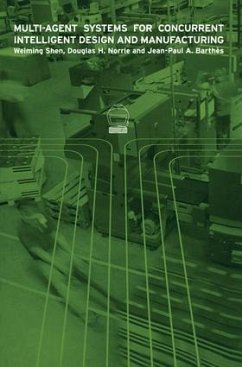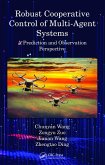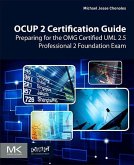Weiming Shen, Douglas H Norrie, J-P Barthes
Multi-Agent Systems for Concurrent Intelligent Design and Manufacturing
Weiming Shen, Douglas H Norrie, J-P Barthes
Multi-Agent Systems for Concurrent Intelligent Design and Manufacturing
- Gebundenes Buch
- Merkliste
- Auf die Merkliste
- Bewerten Bewerten
- Teilen
- Produkt teilen
- Produkterinnerung
- Produkterinnerung
Agent Technology, or Agent-Based Approaches, is a new paradigm for developing software applications. It has been hailed as 'the next significant breakthrough in software development', and 'the new revolution in software' after object technology or object-oriented programming. In this context, an agent is a computer system which is capable of acting autonomously in its environment in order to meet its design objectives. So in the area of concurrent design and manufacturing, a manufacturing resource, namely a machine or an operator, may cooperate and negotiate with other agents for task…mehr
Andere Kunden interessierten sich auch für
![Internet of Things and Big Data Analytics-Based Manufacturing Internet of Things and Big Data Analytics-Based Manufacturing]() Internet of Things and Big Data Analytics-Based Manufacturing125,99 €
Internet of Things and Big Data Analytics-Based Manufacturing125,99 €![Robust Cooperative Control of Multi-Agent Systems Robust Cooperative Control of Multi-Agent Systems]() Chunyan WangRobust Cooperative Control of Multi-Agent Systems164,99 €
Chunyan WangRobust Cooperative Control of Multi-Agent Systems164,99 €![What Every Engineer Should Know about Software Engineering What Every Engineer Should Know about Software Engineering]() Phillip A LaplanteWhat Every Engineer Should Know about Software Engineering154,99 €
Phillip A LaplanteWhat Every Engineer Should Know about Software Engineering154,99 €![Modelling Intelligent Multi-Modal Transit Systems Modelling Intelligent Multi-Modal Transit Systems]() Modelling Intelligent Multi-Modal Transit Systems221,99 €
Modelling Intelligent Multi-Modal Transit Systems221,99 €![Smart and Intelligent Systems Smart and Intelligent Systems]() Smart and Intelligent Systems144,99 €
Smart and Intelligent Systems144,99 €![The Art of Learning The Art of Learning]() Francis T S YuThe Art of Learning73,99 €
Francis T S YuThe Art of Learning73,99 €![Ocup 2 Certification Guide Ocup 2 Certification Guide]() Michael Jesse ChonolesOcup 2 Certification Guide44,99 €
Michael Jesse ChonolesOcup 2 Certification Guide44,99 €-
-
-
Agent Technology, or Agent-Based Approaches, is a new paradigm for developing software applications. It has been hailed as 'the next significant breakthrough in software development', and 'the new revolution in software' after object technology or object-oriented programming. In this context, an agent is a computer system which is capable of acting autonomously in its environment in order to meet its design objectives. So in the area of concurrent design and manufacturing, a manufacturing resource, namely a machine or an operator, may cooperate and negotiate with other agents for task assignment; and an existing engineering software can be integrated with a distributed integrated engineering design and manufacturing system. Hence in agennt based systems, there is no centralized system control structure, and no pre-defined agenda for the system execution, as exist in traditional systems. Both professional engineers and inversity researchers and postgraduates should find this an invaluable presentation of the corresponding theories and methods, with some practical examples for developing multi-agent systems in the domain.
Produktdetails
- Produktdetails
- Verlag: CRC Press
- Seitenzahl: 416
- Erscheinungstermin: 31. August 2000
- Englisch
- Abmessung: 242mm x 163mm x 25mm
- Gewicht: 644g
- ISBN-13: 9780748408825
- ISBN-10: 0748408827
- Artikelnr.: 22050453
- Herstellerkennzeichnung
- Libri GmbH
- Europaallee 1
- 36244 Bad Hersfeld
- gpsr@libri.de
- Verlag: CRC Press
- Seitenzahl: 416
- Erscheinungstermin: 31. August 2000
- Englisch
- Abmessung: 242mm x 163mm x 25mm
- Gewicht: 644g
- ISBN-13: 9780748408825
- ISBN-10: 0748408827
- Artikelnr.: 22050453
- Herstellerkennzeichnung
- Libri GmbH
- Europaallee 1
- 36244 Bad Hersfeld
- gpsr@libri.de
Weiming Shen
Part One: Introduction Chapter 1: General Introduction. 1.1 Motivation. 1.2
Book Organization. 1.3 How To Use This Book. Chapter 2: Collaborative
Design and Manufacturing. 2.1 Introduction. 2.2 Engineering Design. 2.3
Advanced Manufacturing Systems. 2.4 Next Generation Collaborative Design
and Manufacturing Systems. Chapter 3: DAI and Agents. 3.1 Classic AI and
DAI. 3.2 Research Themes in DAI. 3.3 Models of DAI Systems. 3.4 Objects vs.
Agents. 3.5 Different Types of Agents. 3.6. Why Agents for Collaborative
Design and Manufacturing. Part Two: Important Issues Chapter 4: Knowledge
Representation in Agent-Based Concurrent Design and Manufacturing Systems.
4.1 Introduction 4.2 What needs to be Represented. 4.3 How to Represent
Knowledge in Agent-Based Systems. 4.4 Research Literature and Further
References. Chapter 5: Learning in Agent-Based Concurrent Design and
Manufacturing Systems. 5.1 Introdution. 5.2 Why to Learn. 5.3 Single-Agent
Learning or Multi-Agent Learning. 5.4 When to Learn. 5.5 Where to Learn.
5.6 What is to be Learned. 5.7 How to Learn. 5.8 Examples. 5.9 Research
Literature and Additional References. Chapter 6: Agent Structures. 6.1
Introduction. 6.2 Desirable characteristics of an agent. 6.3 Essential
Modules (Components) for agents. 6.4 Different Approaches. 6.5 Comparison
of Different Approaches. 6.6 Research Literature and further References.
Chapter 7: Multi-Agent System Architectures. 7.1 Introduction. 7.2
Organization and System Architectures. 7.3 Different Approaches. 7.4 Select
a suitable system architecture for a specific application. 7.5 Research
Literature and Additional Readings. Chapter 8: Communication, Cooperation
and Coordination. 8.1 Introduction. 8.2 Communication. 8.3 Coordination.
8.4 Cooperation. 8.5 Coordination, Cooperation and Communication. 8.6
Research Literature and Further References. Chapter 9: Collaboration, Task
Decompsition and Allocation. 9.1 Introduction. 9.2 Different Approaches for
Task Decomposition and Allocation. 9.3 Coordinated Task Allocation by
Mediation. 9.4 Distributed Task Allocation. 9.5 Task Decomposition in
MetaMorph: an Example. 9.6 Research Literature and Additional References.
Chapter 10: Negotiation and Conflict Resolution. 10.1 Introduction. 10.2
Classification of Negotiation Categories. 103. Negotiation Protocols. 10.4
Negotiation Strategies. 10.5 Negotiation for Conflict Resolution. 10.6
Examples in Concurrent Design and Manufacturing. 10.7 Research Literature
and Additional Information. Chapter 11: Ontology Problems. 11.1
Introduction. 11.2 What is Ontology? 11.3 Ontology and Knowledge Sharing.
11.4 Ontology Problems in Concurrent Design and Manufacturing. 11.5 Related
concepts, Theories and Methods. 11.6 Ontolingua: A System for Managing
Portable Ontologies. 11.7 Research Literature and Additional References.
Chapter 12: Other Important Issues. 12.1 Introduction. 12.2 Agent
Encapsulation. 12.3 Human machine integration (human participation). 12.4
System dynamics. 12.5. Design and manufacturability assessments. 12.6
Integration of manufacturing Planning, Scheduling and Execution. 12.7
Distributed Dynamic Scheduling. 12.8 Enterprise Integration and Supply
Chain Management. 12.9 Legacy problem. 12.10 External interfaces. Part
Three: Agent-Based Systems for Engineering Design & Manufacturing Chapter
13: Agent-Based Engineering Design Systems. 13.1 Introduction. 13.2 PACT
(PACE) 13.3 SHARE (DSC) 13.4 First-Link, Next-Link and Process Link. 13.5
DIDE. 13.6 SiFAs. 13.7 RAPPID. 13.8 Other projects. 13.9 Summary. Chapter
14: Agent-Based manufacturing Planning, Scheduling and Control. 14.1
Introduction. 14.2 MetaMorph. 14.3 AARIA. 14.4 ADDYMS. 14.5 Other Projects.
14.6 Summary. Chapter 15: Enterprise Integration and Supply Chain
Management. 15.1 Introduction. 15.2 ISCM. 15.3 CIIMPLEX. 15.4 MetaMorph II.
15.5 AIMS. 15.6 Other Projects. 15.7 Summary. Part Five: Developing
Agent-Based Design and Manufacturing Systems Chapter 16: Methodology,
Standards, Tools, Languages, and Frameworks. 16.1 Introduction. 16.2 Tools
and Framework. 16.3 Methodology, Languages, and Standards. 16.4 Further
references. Chapter 17: Building Agent-Based Design and Manufacturing
Systems. 17.1 Introduction. 17.2 Selecting or developing an agent
architecture. 17.3 Selecting an approach for agent organization. 17.4
Selecting or developing protocols for inter-agent communication. 17.5
Developing mechanisms for cooperation, coordination and negotiation. 17.6
Selecting platforms, tools and languages. 17.7 Agent-Oriented Design and
Analysis. 17.8 Simulation and Implementation. 17.9 Testing, Debugging and
Evaluation. Chapter 2: Collaborative Design and Manufacturing, Chapter 3:
DAI and Agents. Part Two: Important Issues Chapter 4: Knowledge
Representation in Agent-Based Concurrent Design and Manufacturing Systems.
Chapter 5: Learning in Agent-Based Concurrent Design and Manufacturing
Systems. Chapter 6: Agent Structures. Chapter 7: Multi-Agent System
Architectures. Chapter 8: Communication, Cooperation and Coordination.
Chapter 9: Collaboration, Task Decomposition and Allocation. Chapter 10:
Negotiation and Conflict Resolution. Chapter 11: Ontology Problems. Chapter
12: Other Important Issues. Part Three: Agent-Based Systems for Engineering
Design and Manufacturing Chapter 13: Agent-Based Engineering Design
Systems. Chapter 14: Agent-Based manufacturing Planning, Scheduling and
Control. Chapter 15: Enterprise Integration and Supply Chain Management.
Part Four: Developing Agent-Based Design and Manufacturing Systems Chapter
16: Methodlogy, Standards, Tools, Languages, and Frameworks
Book Organization. 1.3 How To Use This Book. Chapter 2: Collaborative
Design and Manufacturing. 2.1 Introduction. 2.2 Engineering Design. 2.3
Advanced Manufacturing Systems. 2.4 Next Generation Collaborative Design
and Manufacturing Systems. Chapter 3: DAI and Agents. 3.1 Classic AI and
DAI. 3.2 Research Themes in DAI. 3.3 Models of DAI Systems. 3.4 Objects vs.
Agents. 3.5 Different Types of Agents. 3.6. Why Agents for Collaborative
Design and Manufacturing. Part Two: Important Issues Chapter 4: Knowledge
Representation in Agent-Based Concurrent Design and Manufacturing Systems.
4.1 Introduction 4.2 What needs to be Represented. 4.3 How to Represent
Knowledge in Agent-Based Systems. 4.4 Research Literature and Further
References. Chapter 5: Learning in Agent-Based Concurrent Design and
Manufacturing Systems. 5.1 Introdution. 5.2 Why to Learn. 5.3 Single-Agent
Learning or Multi-Agent Learning. 5.4 When to Learn. 5.5 Where to Learn.
5.6 What is to be Learned. 5.7 How to Learn. 5.8 Examples. 5.9 Research
Literature and Additional References. Chapter 6: Agent Structures. 6.1
Introduction. 6.2 Desirable characteristics of an agent. 6.3 Essential
Modules (Components) for agents. 6.4 Different Approaches. 6.5 Comparison
of Different Approaches. 6.6 Research Literature and further References.
Chapter 7: Multi-Agent System Architectures. 7.1 Introduction. 7.2
Organization and System Architectures. 7.3 Different Approaches. 7.4 Select
a suitable system architecture for a specific application. 7.5 Research
Literature and Additional Readings. Chapter 8: Communication, Cooperation
and Coordination. 8.1 Introduction. 8.2 Communication. 8.3 Coordination.
8.4 Cooperation. 8.5 Coordination, Cooperation and Communication. 8.6
Research Literature and Further References. Chapter 9: Collaboration, Task
Decompsition and Allocation. 9.1 Introduction. 9.2 Different Approaches for
Task Decomposition and Allocation. 9.3 Coordinated Task Allocation by
Mediation. 9.4 Distributed Task Allocation. 9.5 Task Decomposition in
MetaMorph: an Example. 9.6 Research Literature and Additional References.
Chapter 10: Negotiation and Conflict Resolution. 10.1 Introduction. 10.2
Classification of Negotiation Categories. 103. Negotiation Protocols. 10.4
Negotiation Strategies. 10.5 Negotiation for Conflict Resolution. 10.6
Examples in Concurrent Design and Manufacturing. 10.7 Research Literature
and Additional Information. Chapter 11: Ontology Problems. 11.1
Introduction. 11.2 What is Ontology? 11.3 Ontology and Knowledge Sharing.
11.4 Ontology Problems in Concurrent Design and Manufacturing. 11.5 Related
concepts, Theories and Methods. 11.6 Ontolingua: A System for Managing
Portable Ontologies. 11.7 Research Literature and Additional References.
Chapter 12: Other Important Issues. 12.1 Introduction. 12.2 Agent
Encapsulation. 12.3 Human machine integration (human participation). 12.4
System dynamics. 12.5. Design and manufacturability assessments. 12.6
Integration of manufacturing Planning, Scheduling and Execution. 12.7
Distributed Dynamic Scheduling. 12.8 Enterprise Integration and Supply
Chain Management. 12.9 Legacy problem. 12.10 External interfaces. Part
Three: Agent-Based Systems for Engineering Design & Manufacturing Chapter
13: Agent-Based Engineering Design Systems. 13.1 Introduction. 13.2 PACT
(PACE) 13.3 SHARE (DSC) 13.4 First-Link, Next-Link and Process Link. 13.5
DIDE. 13.6 SiFAs. 13.7 RAPPID. 13.8 Other projects. 13.9 Summary. Chapter
14: Agent-Based manufacturing Planning, Scheduling and Control. 14.1
Introduction. 14.2 MetaMorph. 14.3 AARIA. 14.4 ADDYMS. 14.5 Other Projects.
14.6 Summary. Chapter 15: Enterprise Integration and Supply Chain
Management. 15.1 Introduction. 15.2 ISCM. 15.3 CIIMPLEX. 15.4 MetaMorph II.
15.5 AIMS. 15.6 Other Projects. 15.7 Summary. Part Five: Developing
Agent-Based Design and Manufacturing Systems Chapter 16: Methodology,
Standards, Tools, Languages, and Frameworks. 16.1 Introduction. 16.2 Tools
and Framework. 16.3 Methodology, Languages, and Standards. 16.4 Further
references. Chapter 17: Building Agent-Based Design and Manufacturing
Systems. 17.1 Introduction. 17.2 Selecting or developing an agent
architecture. 17.3 Selecting an approach for agent organization. 17.4
Selecting or developing protocols for inter-agent communication. 17.5
Developing mechanisms for cooperation, coordination and negotiation. 17.6
Selecting platforms, tools and languages. 17.7 Agent-Oriented Design and
Analysis. 17.8 Simulation and Implementation. 17.9 Testing, Debugging and
Evaluation. Chapter 2: Collaborative Design and Manufacturing, Chapter 3:
DAI and Agents. Part Two: Important Issues Chapter 4: Knowledge
Representation in Agent-Based Concurrent Design and Manufacturing Systems.
Chapter 5: Learning in Agent-Based Concurrent Design and Manufacturing
Systems. Chapter 6: Agent Structures. Chapter 7: Multi-Agent System
Architectures. Chapter 8: Communication, Cooperation and Coordination.
Chapter 9: Collaboration, Task Decomposition and Allocation. Chapter 10:
Negotiation and Conflict Resolution. Chapter 11: Ontology Problems. Chapter
12: Other Important Issues. Part Three: Agent-Based Systems for Engineering
Design and Manufacturing Chapter 13: Agent-Based Engineering Design
Systems. Chapter 14: Agent-Based manufacturing Planning, Scheduling and
Control. Chapter 15: Enterprise Integration and Supply Chain Management.
Part Four: Developing Agent-Based Design and Manufacturing Systems Chapter
16: Methodlogy, Standards, Tools, Languages, and Frameworks
Part One: Introduction Chapter 1: General Introduction. 1.1 Motivation. 1.2
Book Organization. 1.3 How To Use This Book. Chapter 2: Collaborative
Design and Manufacturing. 2.1 Introduction. 2.2 Engineering Design. 2.3
Advanced Manufacturing Systems. 2.4 Next Generation Collaborative Design
and Manufacturing Systems. Chapter 3: DAI and Agents. 3.1 Classic AI and
DAI. 3.2 Research Themes in DAI. 3.3 Models of DAI Systems. 3.4 Objects vs.
Agents. 3.5 Different Types of Agents. 3.6. Why Agents for Collaborative
Design and Manufacturing. Part Two: Important Issues Chapter 4: Knowledge
Representation in Agent-Based Concurrent Design and Manufacturing Systems.
4.1 Introduction 4.2 What needs to be Represented. 4.3 How to Represent
Knowledge in Agent-Based Systems. 4.4 Research Literature and Further
References. Chapter 5: Learning in Agent-Based Concurrent Design and
Manufacturing Systems. 5.1 Introdution. 5.2 Why to Learn. 5.3 Single-Agent
Learning or Multi-Agent Learning. 5.4 When to Learn. 5.5 Where to Learn.
5.6 What is to be Learned. 5.7 How to Learn. 5.8 Examples. 5.9 Research
Literature and Additional References. Chapter 6: Agent Structures. 6.1
Introduction. 6.2 Desirable characteristics of an agent. 6.3 Essential
Modules (Components) for agents. 6.4 Different Approaches. 6.5 Comparison
of Different Approaches. 6.6 Research Literature and further References.
Chapter 7: Multi-Agent System Architectures. 7.1 Introduction. 7.2
Organization and System Architectures. 7.3 Different Approaches. 7.4 Select
a suitable system architecture for a specific application. 7.5 Research
Literature and Additional Readings. Chapter 8: Communication, Cooperation
and Coordination. 8.1 Introduction. 8.2 Communication. 8.3 Coordination.
8.4 Cooperation. 8.5 Coordination, Cooperation and Communication. 8.6
Research Literature and Further References. Chapter 9: Collaboration, Task
Decompsition and Allocation. 9.1 Introduction. 9.2 Different Approaches for
Task Decomposition and Allocation. 9.3 Coordinated Task Allocation by
Mediation. 9.4 Distributed Task Allocation. 9.5 Task Decomposition in
MetaMorph: an Example. 9.6 Research Literature and Additional References.
Chapter 10: Negotiation and Conflict Resolution. 10.1 Introduction. 10.2
Classification of Negotiation Categories. 103. Negotiation Protocols. 10.4
Negotiation Strategies. 10.5 Negotiation for Conflict Resolution. 10.6
Examples in Concurrent Design and Manufacturing. 10.7 Research Literature
and Additional Information. Chapter 11: Ontology Problems. 11.1
Introduction. 11.2 What is Ontology? 11.3 Ontology and Knowledge Sharing.
11.4 Ontology Problems in Concurrent Design and Manufacturing. 11.5 Related
concepts, Theories and Methods. 11.6 Ontolingua: A System for Managing
Portable Ontologies. 11.7 Research Literature and Additional References.
Chapter 12: Other Important Issues. 12.1 Introduction. 12.2 Agent
Encapsulation. 12.3 Human machine integration (human participation). 12.4
System dynamics. 12.5. Design and manufacturability assessments. 12.6
Integration of manufacturing Planning, Scheduling and Execution. 12.7
Distributed Dynamic Scheduling. 12.8 Enterprise Integration and Supply
Chain Management. 12.9 Legacy problem. 12.10 External interfaces. Part
Three: Agent-Based Systems for Engineering Design & Manufacturing Chapter
13: Agent-Based Engineering Design Systems. 13.1 Introduction. 13.2 PACT
(PACE) 13.3 SHARE (DSC) 13.4 First-Link, Next-Link and Process Link. 13.5
DIDE. 13.6 SiFAs. 13.7 RAPPID. 13.8 Other projects. 13.9 Summary. Chapter
14: Agent-Based manufacturing Planning, Scheduling and Control. 14.1
Introduction. 14.2 MetaMorph. 14.3 AARIA. 14.4 ADDYMS. 14.5 Other Projects.
14.6 Summary. Chapter 15: Enterprise Integration and Supply Chain
Management. 15.1 Introduction. 15.2 ISCM. 15.3 CIIMPLEX. 15.4 MetaMorph II.
15.5 AIMS. 15.6 Other Projects. 15.7 Summary. Part Five: Developing
Agent-Based Design and Manufacturing Systems Chapter 16: Methodology,
Standards, Tools, Languages, and Frameworks. 16.1 Introduction. 16.2 Tools
and Framework. 16.3 Methodology, Languages, and Standards. 16.4 Further
references. Chapter 17: Building Agent-Based Design and Manufacturing
Systems. 17.1 Introduction. 17.2 Selecting or developing an agent
architecture. 17.3 Selecting an approach for agent organization. 17.4
Selecting or developing protocols for inter-agent communication. 17.5
Developing mechanisms for cooperation, coordination and negotiation. 17.6
Selecting platforms, tools and languages. 17.7 Agent-Oriented Design and
Analysis. 17.8 Simulation and Implementation. 17.9 Testing, Debugging and
Evaluation. Chapter 2: Collaborative Design and Manufacturing, Chapter 3:
DAI and Agents. Part Two: Important Issues Chapter 4: Knowledge
Representation in Agent-Based Concurrent Design and Manufacturing Systems.
Chapter 5: Learning in Agent-Based Concurrent Design and Manufacturing
Systems. Chapter 6: Agent Structures. Chapter 7: Multi-Agent System
Architectures. Chapter 8: Communication, Cooperation and Coordination.
Chapter 9: Collaboration, Task Decomposition and Allocation. Chapter 10:
Negotiation and Conflict Resolution. Chapter 11: Ontology Problems. Chapter
12: Other Important Issues. Part Three: Agent-Based Systems for Engineering
Design and Manufacturing Chapter 13: Agent-Based Engineering Design
Systems. Chapter 14: Agent-Based manufacturing Planning, Scheduling and
Control. Chapter 15: Enterprise Integration and Supply Chain Management.
Part Four: Developing Agent-Based Design and Manufacturing Systems Chapter
16: Methodlogy, Standards, Tools, Languages, and Frameworks
Book Organization. 1.3 How To Use This Book. Chapter 2: Collaborative
Design and Manufacturing. 2.1 Introduction. 2.2 Engineering Design. 2.3
Advanced Manufacturing Systems. 2.4 Next Generation Collaborative Design
and Manufacturing Systems. Chapter 3: DAI and Agents. 3.1 Classic AI and
DAI. 3.2 Research Themes in DAI. 3.3 Models of DAI Systems. 3.4 Objects vs.
Agents. 3.5 Different Types of Agents. 3.6. Why Agents for Collaborative
Design and Manufacturing. Part Two: Important Issues Chapter 4: Knowledge
Representation in Agent-Based Concurrent Design and Manufacturing Systems.
4.1 Introduction 4.2 What needs to be Represented. 4.3 How to Represent
Knowledge in Agent-Based Systems. 4.4 Research Literature and Further
References. Chapter 5: Learning in Agent-Based Concurrent Design and
Manufacturing Systems. 5.1 Introdution. 5.2 Why to Learn. 5.3 Single-Agent
Learning or Multi-Agent Learning. 5.4 When to Learn. 5.5 Where to Learn.
5.6 What is to be Learned. 5.7 How to Learn. 5.8 Examples. 5.9 Research
Literature and Additional References. Chapter 6: Agent Structures. 6.1
Introduction. 6.2 Desirable characteristics of an agent. 6.3 Essential
Modules (Components) for agents. 6.4 Different Approaches. 6.5 Comparison
of Different Approaches. 6.6 Research Literature and further References.
Chapter 7: Multi-Agent System Architectures. 7.1 Introduction. 7.2
Organization and System Architectures. 7.3 Different Approaches. 7.4 Select
a suitable system architecture for a specific application. 7.5 Research
Literature and Additional Readings. Chapter 8: Communication, Cooperation
and Coordination. 8.1 Introduction. 8.2 Communication. 8.3 Coordination.
8.4 Cooperation. 8.5 Coordination, Cooperation and Communication. 8.6
Research Literature and Further References. Chapter 9: Collaboration, Task
Decompsition and Allocation. 9.1 Introduction. 9.2 Different Approaches for
Task Decomposition and Allocation. 9.3 Coordinated Task Allocation by
Mediation. 9.4 Distributed Task Allocation. 9.5 Task Decomposition in
MetaMorph: an Example. 9.6 Research Literature and Additional References.
Chapter 10: Negotiation and Conflict Resolution. 10.1 Introduction. 10.2
Classification of Negotiation Categories. 103. Negotiation Protocols. 10.4
Negotiation Strategies. 10.5 Negotiation for Conflict Resolution. 10.6
Examples in Concurrent Design and Manufacturing. 10.7 Research Literature
and Additional Information. Chapter 11: Ontology Problems. 11.1
Introduction. 11.2 What is Ontology? 11.3 Ontology and Knowledge Sharing.
11.4 Ontology Problems in Concurrent Design and Manufacturing. 11.5 Related
concepts, Theories and Methods. 11.6 Ontolingua: A System for Managing
Portable Ontologies. 11.7 Research Literature and Additional References.
Chapter 12: Other Important Issues. 12.1 Introduction. 12.2 Agent
Encapsulation. 12.3 Human machine integration (human participation). 12.4
System dynamics. 12.5. Design and manufacturability assessments. 12.6
Integration of manufacturing Planning, Scheduling and Execution. 12.7
Distributed Dynamic Scheduling. 12.8 Enterprise Integration and Supply
Chain Management. 12.9 Legacy problem. 12.10 External interfaces. Part
Three: Agent-Based Systems for Engineering Design & Manufacturing Chapter
13: Agent-Based Engineering Design Systems. 13.1 Introduction. 13.2 PACT
(PACE) 13.3 SHARE (DSC) 13.4 First-Link, Next-Link and Process Link. 13.5
DIDE. 13.6 SiFAs. 13.7 RAPPID. 13.8 Other projects. 13.9 Summary. Chapter
14: Agent-Based manufacturing Planning, Scheduling and Control. 14.1
Introduction. 14.2 MetaMorph. 14.3 AARIA. 14.4 ADDYMS. 14.5 Other Projects.
14.6 Summary. Chapter 15: Enterprise Integration and Supply Chain
Management. 15.1 Introduction. 15.2 ISCM. 15.3 CIIMPLEX. 15.4 MetaMorph II.
15.5 AIMS. 15.6 Other Projects. 15.7 Summary. Part Five: Developing
Agent-Based Design and Manufacturing Systems Chapter 16: Methodology,
Standards, Tools, Languages, and Frameworks. 16.1 Introduction. 16.2 Tools
and Framework. 16.3 Methodology, Languages, and Standards. 16.4 Further
references. Chapter 17: Building Agent-Based Design and Manufacturing
Systems. 17.1 Introduction. 17.2 Selecting or developing an agent
architecture. 17.3 Selecting an approach for agent organization. 17.4
Selecting or developing protocols for inter-agent communication. 17.5
Developing mechanisms for cooperation, coordination and negotiation. 17.6
Selecting platforms, tools and languages. 17.7 Agent-Oriented Design and
Analysis. 17.8 Simulation and Implementation. 17.9 Testing, Debugging and
Evaluation. Chapter 2: Collaborative Design and Manufacturing, Chapter 3:
DAI and Agents. Part Two: Important Issues Chapter 4: Knowledge
Representation in Agent-Based Concurrent Design and Manufacturing Systems.
Chapter 5: Learning in Agent-Based Concurrent Design and Manufacturing
Systems. Chapter 6: Agent Structures. Chapter 7: Multi-Agent System
Architectures. Chapter 8: Communication, Cooperation and Coordination.
Chapter 9: Collaboration, Task Decomposition and Allocation. Chapter 10:
Negotiation and Conflict Resolution. Chapter 11: Ontology Problems. Chapter
12: Other Important Issues. Part Three: Agent-Based Systems for Engineering
Design and Manufacturing Chapter 13: Agent-Based Engineering Design
Systems. Chapter 14: Agent-Based manufacturing Planning, Scheduling and
Control. Chapter 15: Enterprise Integration and Supply Chain Management.
Part Four: Developing Agent-Based Design and Manufacturing Systems Chapter
16: Methodlogy, Standards, Tools, Languages, and Frameworks








